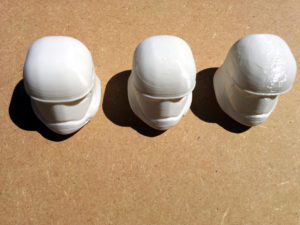In 3D printing, as in many other fields, you can choose between different qualities of work ranging from draft quality to fine quality. As far as we are concerned, the concept of quality concerns the layer height. It will not affect our resolutions on the X axis or on the Y axis, but only on the Z axis (vertical).
To illustrate this article, I printed the same object, a Storm Trooper helmet, in three different resolutions:
At 0.1 mm per layer, the first impression on the left. The estimated printing time was 3:42 (4:45 after actually heating). The amount of filament expected was 19 g, or 6.43 m.
At 0.2 mm per layer, the impression of the medium. The estimated printing time was 1h50 (2h21 after actually heating). The amount of filament expected was 19 g, or 6.35 m.
At 0.3 mm per layer, the rightmost impression. The estimated printing time was 1h15 (1h35 after actually heating). The amount of filament expected was 19 g, or 6.43 m.
Note that the quality has a great impact on the printing time. It turns out that this is exactly what we are asking. On the other hand, it hardly affects the quantity of matter. The little change that quality applies to the geometry of the part will eventually alter the way your slicer will generate its supports. This is the small difference in filament length that we see here on printing in 0.2 mm per layer.
The differences in quality will be much more visible on parts with organic shapes, like here. And less on technical forms, rich in flat surfaces. This is the reason why I chose an object with organic forms. The top of the helmet being the very example.
On the rightmost impression, with the eye, we even see that the printer has not managed to close the entire helmet. There are gaps between certain layers.
Note that the layer height must not exceed 80% of the nozzle diameter. With a 0.4 mm diameter nozzle, this gives a maximum height of 0.32 mm. That said, you can exchange your nozzle for a larger diameter. More information on the (french) article Tout sur les buses de diamètre différent, from the Filament-ABS website.
